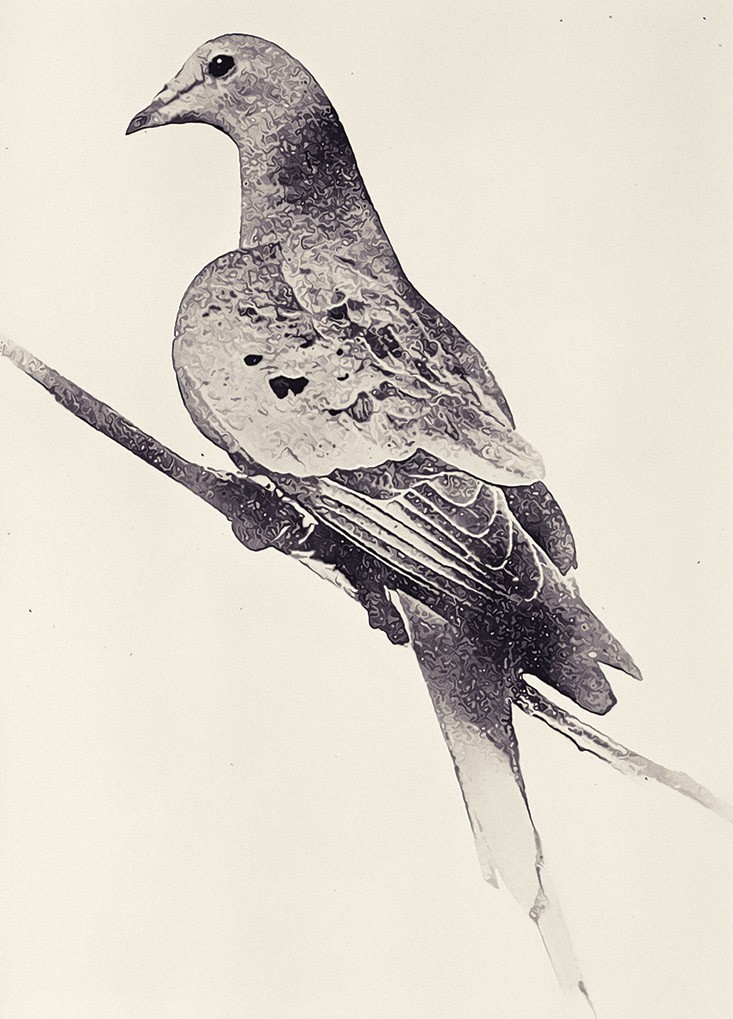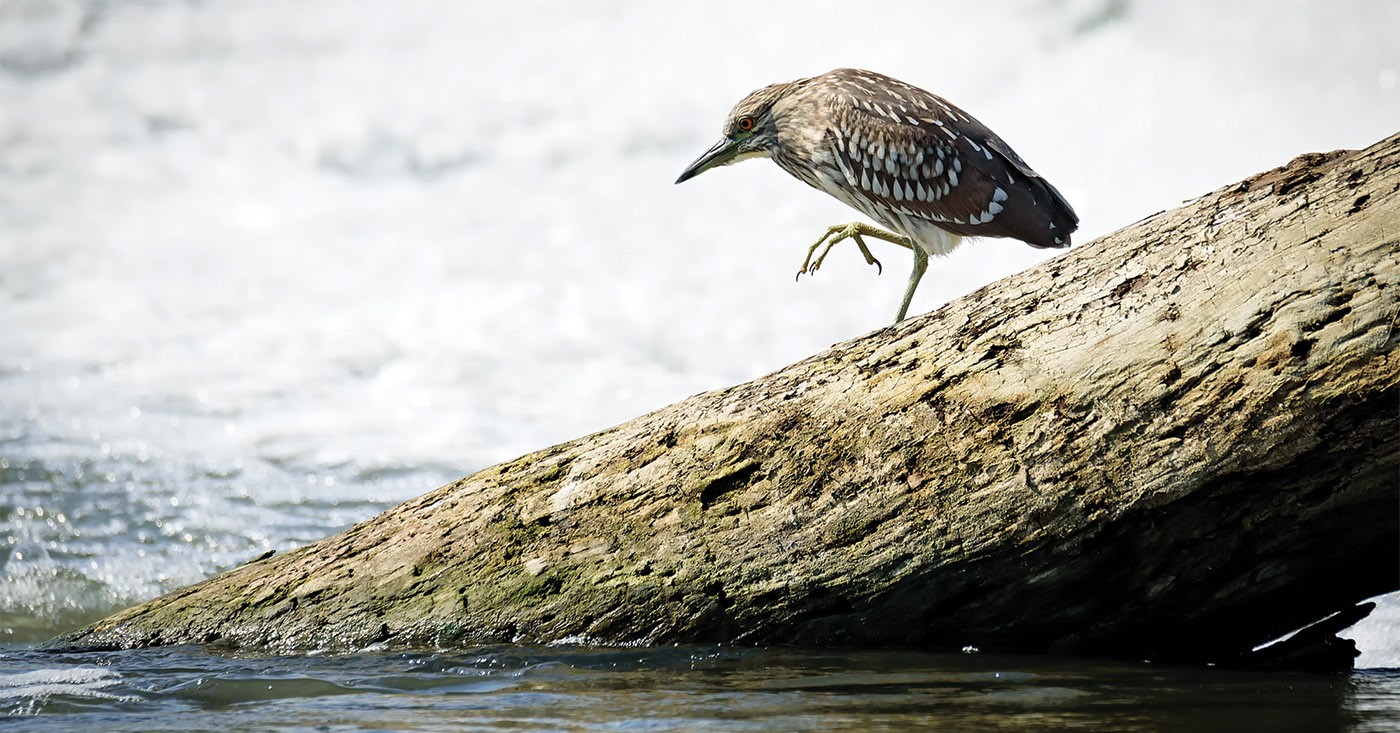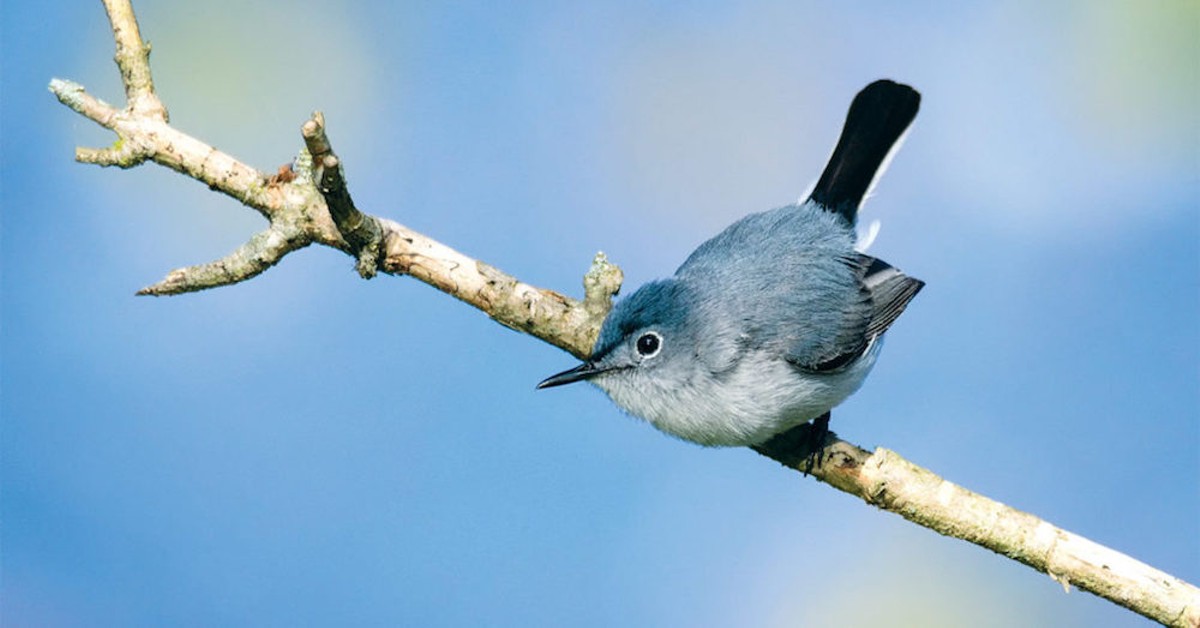On an autumn morning in 1813, John James Audubon set out from his home in Henderson, Kentucky, traveling east by horseback toward Louisville. A short distance beyond what is today Hardinsburg, steering his sorrel over a buffalo trace through what he describes as a “Barrens” — probably scrub oak and grasslands, spotted by underbrush rooted in poor soil — he encountered what was to be one of the most memorable experiences of his life: waves upon waves of Passenger Pigeons, Ectopistes migratorius, in flight.
“I observed the Pigeons flying,” he writes, “from northeast to southwest in greater numbers than I thought I had ever seen them before.”
The numbers of birds — it is estimated there were 3 billion of them in Audubon’s time — clearly astonished him. He dismounted and tried to keep count, making a dot for each flock with a pencil. He was soon overwhelmed.
In barely over 20 minutes, he counted 163 separate flocks. “The air was literally filled with Pigeons,” he writes, “the light of noonday was obscured as by an eclipse; the dung fell in spots not unlike melting flakes of snow; and the continued buzz of wings had a tendency to lull my senses to repose.”
He observed the Passenger Pigeons flying continuously throughout the day, an unceasing torrent of birds, from the barrens to the mouth of the Salt River — the village of West Point — where he dined at Young’s Inn, having ridden some 40 miles in the interim. None of the birds, he noted, roosted. There was no mast, Audubon reasons — no acorns nor wild nuts to bring them to the ground, either of which the birds would devour, he recounts, ravenously, to the point they would often suffocate on them. They flew too high, he goes on to say, to reach with a rifle shot, though clearly some were attempting it — “nor did the reports disturb them in the least,” he adds. Shooting Passenger Pigeons was all too common, as he would later memorably, if horrifically, describe.

But what he could not describe, he insisted, was “the extreme beauty of their aerial evolutions” when a hawk appeared. The birds apparently tightened into undulating clouds, diving swiftly toward the earth and rising, swept together into whirling columns “with a noise like thunder,” which resembled, to him, “the coils of a gigantic serpent.” When he reached Louisville at sunset, having traveled nearly 60 miles from Hardinsburg, where he first sighted the flocks, Audubon found to his amazement the pigeons were still passing overhead. They continued, undiminished, for three days. The air was rich with their odor.
Along the banks of the Ohio, men and their sons were shooting indiscriminately into the sky as the pigeons flew low to the water, crossing the Ohio River. The people of Louisville apparently ate nothing but pigeon meat for at least a week. Audubon, describing the slaughter, amounts the deafening roar of gunfire to “shooting at the pilgrims.”
It is understandable that Audubon would have thought the Passenger Pigeons, by stint of their sheer numbers, indestructible — even against “the tyrant of the creation, man.” Confronted with what he estimates to be over a billion birds and the nearly hysterical slaughter perpetrated by farmers armed with rifles, poles and axes, he demurs, confident in nature’s fecundity. “People unacquainted with these birds might naturally conclude that such dreadful havoc would soon put an end to the species,” he muses. “But I have satisfied myself by long observation that nothing but the gradual diminution of our forests can accomplish their decrease … ”
Audubon, for his part, was wrong, but partly so. The killing for meat, much of it commercial, did, in fact, contribute to the demise of the Passenger Pigeon. And the nod to deforestation proved prophetic. When a bill to protect the Passenger Pigeon was introduced in the Ohio State Legislature in 1857, only six years after Audubon’s death, it failed. “The passenger pigeon needs no protection,” a senate committee reported. The pigeon was, according to this report, “Wonderfully prolific … and no ordinary destruction can lessen them.”
But the slaughters of the pigeons were, of course, far from ordinary. They were, rather, routine. And brutal. Men would wait at roosting places — a notable one that Audubon details was on the banks of the Green River in southern Kentucky — with their ammunition and wagons. They brought salt and iron pots. Torches, clap nets. When the birds arrived, men beat them from the air with poles. The sound of rifles traveled for miles. Two farmers herded 300 hogs to feast on the carcasses the men left, and what remained after that was scavenged by wolves, foxes, eagles and vultures.
The destruction perpetrated on the birds was not limited in responsibility to people in the countryside, either. Schooners floated thousands of birds down the Hudson River to be sold on the New York wharves for a penny apiece. Birds lay in the markets in piles.

By the end of the 19th century, bills were passed in Michigan and Pennsylvania to limit hunting, but they were either poorly enforced or toothless in vision. In either case, action was too late. The eradication of forest to create farmlands is likewise to blame. Within a century of Audubon’s arrival in Louisville — “by candlelight,” he wrote poetically, the birds still thundering in the sky — the Passenger Pigeon would be extinct. They needed, it turned out, the massive flocks in which to mate. They were, by any measure, gregarious, and when the numbers dwindled to a handful, that handful did not mate. The final one, named Martha, as many of us learned in school, died in the Cincinnati Zoo on a late summer day in 1914.
What history has taught us about the extinction of the Passenger Pigeon seems largely obscured — the fact that is passed over is that it is our own ancestors, perhaps as few as four or five generations past, who destroyed a population of creatures that was, by all accounts, extraordinary. To destroy billions of lives, for most of us, is beyond the scope of our imagination. What we are left with is a terrible silence that, even now, we can barely discern, let alone name.
• • •
I am standing near the shores of the Ohio River on Shippingport Island, beneath towering black cottonwoods, feeling the repose that Audubon spoke of. Above me, nested in the trees, are three kinds of birds: Great Egrets, Black-crowned Night Herons, and Double-crested Cormorants.That all these birds are colonial nesters makes the scene extraordinary. Standing on the silt, which sprouts poison ivy and lesser celandine, I look upward as if into an Amazonian canopy. The noises of grunting, barking birds pierces the air. Behind me, the interstate, on the far side of the canal, fades from consciousness.
Brainard Palmer-Ball, an ornithologist retired from what is now the Kentucky State Nature Preserves Commission, is carefully counting the nests. He points upward to the crown of a tree, where an egret, Ardea alba, a male, is perched. “You can see the breeding plumage on his back,” he says. I crane my neck and raise the field glasses. The long plumes, called aigrettes, will be lifted during its courtship displays. At one point, during the19th century, these plumes were so prized for women’s’ hats that by the end of that century, the great white egrets were hunted nearly to extinction. Today, the egret serves as the symbol for the National Audubon Society.
An egret in flight — they soar at only two wingbeats a second at about 25 mph — is both a graceful and familiar sight in the city of Louisville, and not just along the waterfront. They travel far from the island — actually a peninsula severed from the mainland by the McAlpine Locks — in search of food. They can be seen flying over downtown, even over industrialized areas and distant neighborhoods. In my neighborhood they follow, I would guess, the path of Beargrass Creek.
The night herons, Nycticorax nycticorax, prefer smaller trees. Everywhere along the shore, paired birds roost on what appear to be hastily built stick nests, far from the delicate weave we associate with songbirds. Many, not squawking or jostling about, perch still as leaves unstirred by wind. They are incubating, and so we keep our distance and remain as quiet as we can. The ground beneath their nests is spotted with their white droppings — a defensive gesture, Palmer-Ball tells me. “The babies throw up fish,” he adds.
One of his concerns is the noise generated by Thunder Over Louisville. Such explosive, continuous noise as air shows and fireworks can disturb the birds to the point they may abandon their nests and their eggs. The fear is that such a disturbance would dissuade them from returning to this breeding ground. “They were still courting a week ago,” Palmer-Ball said before we left the road and started into the woods, following the trestle of the K&I Railroad Bridge. “I don’t think they’re going to be too skittish.”
But the birds clearly are wary. I can feel their cautious gaze upon me. They sometimes leap into flight, restless, and circle before settling back in the trees. “I think they’re more annoyed with each other than with us,” Palmer-Ball reasons. He tells me that, though this is a historical nesting area, the birds abandoned these trees along the riverbanks for some 20 years before returning about a decade ago.
This stretch of Shippingport Island — we can see downtown from the gravel road — is within the boundaries of a national conservation area inaccessible to the public. We are driven through the gates by Evan McKinney, a park ranger for the U.S. Army Corps of Engineers, who divides his time between the area around the canal and dam and Taylorsville Lake. McKinney, too, is familiar with the birds of the island, including the osprey nested on a cell tower, which he points out to me, as well as the nesting bald eagles and great blue herons, not to mention the wild turkeys that he spotted walking one day along the elevated railroad tracks. He loans me the Nikon binoculars I’m using to watch the behaviors of birds I am unlikely to see in such numbers again.
The cormorants, Phalacrocorax auratus, too, attract my attention. They nest in some cases quite close to the herons. “Everyone mixes in,” Palmer-Ball notes. I see a cormorant’s rapid wingbeat above the river, its bill clamped on sticks for its nest. Cormorants are migratory. From the Falls of the Ohio, a bit downstream, I have seen, through a spotting scope, these birds along the spillways, drying their wings in the sun.
Each of these birds in this aviary can live 20 years, even more.
Palmer-Ball, within the space of perhaps an hour — it’s hard to judge the passage of time, I am so absorbed in watching the birds — counts some 20 egret nests, 40 to 45 night heron nests and 10 cormorant nests. Some are still building.
What is always astonishing to me about long-time birders is how quickly they can identify birds and usually by sound alone. During the course of our walk in the trees, both in the woods and along the road, Palmer-Ball identifies a number of songbirds, including migratory species. Baltimore Oriole, Orchard Oriole. Gnatcatchers, White-throated Sparrows, Warbling Vireos. A Brown Thrasher, a Yellow Warbler. Each he identifies, initially, by its song. He then searches the trees, especially where the wooded areas meet the open fields, for their skittering flight.
We watch the birds for a time, moving slowly over driftwood carried by floodwaters, over the enormous amounts of plastic trash carried to the island. Satisfied, Palmer-Ball signals to me, and we push through a tangle of honeysuckle back to the road. “It looks like everybody is all right,” he says of the nesters. “Content.”
He hopes, he says, that the birds imagined Thunder Over Louisville to be only a passing storm. Not as a persistent threat.
• • •
It is captivating to think that flocks of such proportions as the Passenger Pigeon passed over Kentucky and likely the city of Louisville, as well, at least historically. And yet most of us would find it hard to imagine such fecundity. We have virtually no precedent.
Even in the wake of such profound extinctions as that of the Passenger Pigeon — perhaps even in spite of it — the area around the Ohio River, and Jefferson County in particular, thrives with avian life. Over the course of one year, 2015, members of Louisville’s Beckham Bird Club counted exactly 250 species of birds. A portion of those are year-round residents, like the ubiquitous Northern Cardinal, the Carolina Wren, the Blue Jay. But many more are migratory, ranging from warblers to shore birds to hummingbirds.
One can almost ignore, given the vibrant bird populations, the conditions of climate change, though we do so at our peril. Birds are as much bellwethers of ecological change as weather patterns. The migratory Great White Egrets, for example, have been arriving a full month early, soaring into the region in March. And birds must arrive precisely as their food source — say, insects, which are themselves dependent on the timely blooming of flowers — begins to flourish.
There are instances of the migrations of birds over Louisville, however, that might hold our attention now. Sandhill Cranes, for one. Nearly a decade ago, standing in a mall parking lot in the autumn, I heard in the sky over St. Matthews the calls of hundreds of the cranes. Looking up, I saw them in a great circle, wheeling in the sunlight. I held my daughter in the crook of my arm — she was a year old — and turned her face to the sky, saying, “Even if you don’t remember this, I want you to see it.”
A few people walked steadfastly to and from their cars. A few looked up, but no one paused. I wanted, naturally, to share the event. After a few minutes, perhaps less, I heard in the sky to the north the sound of more; turning, I saw several large “V” formations arriving — hundreds of cranes. When the two bands met — I couldn’t even estimate how many birds there were by now — they swirled together, hundreds of feet in the air, and then began breaking into large groups, turning toward the south, disappearing slowly from view, their songs receding.
When I asked Palmer-Ball why we, in the Ohio River Valley, even in an urban area like Louisville, have so many birds — and more, I point out, than, say, Portland, Oregon, where I saw very few varieties of birds, he answers that we have two fortunate occurrences here. For one, we are on traditional migratory routes — warblers, certainly, and cranes, as well. We also have what he called the “green islands” like Shippingport Island, or Cherokee Park, or Shawnee Park. Birds see these spots from the air, and they pause here. In the case of some areas, like the knobs to the south of town in the Jefferson Memorial Forest, you might see a bird as seemingly uncommon as a Hooded Warbler actually nested there.
We talked about some sightings I’d seen. Bald Eagles nested along Interstate 64. A band of Cedar Waxwings on the shore of the pond in Waverly Park, or at the edge of the woods in Locust Grove. To witness any of these, as surely as Audubon witnessed what amounted to millions of birds in what must have been a thunder of wingbeats, is to feel oneself a part of a country. So it is that in whatever grief I might find myself, whatever sense of dislocation, I can turn to the birds.
• • •
Del Striegel, at 72 years old, has been birdwatching for 45 years. For 12 of those years, he has volunteered at the Falls of the Ohio State Park, where I met him.On this mid-April day, he is giving a slide show on the birds common to the area around the falls, both on the Indiana and Kentucky sides. He points out that of the 900 species of birds in North America, 275 have been counted at the falls. Between 1808 and 1810, he notes, John James Audubon visited the Falls of the Ohio to document its birds.
The presentation is as much about how to birdwatch as it is about the birds themselves. How to identify the birds, for example: by silhouette, flight pattern, field marks, color, posture, size, habitat and song. Think of the silhouette of a cardinal, the bobbing flight pattern of a flicker. Note the markings on a Song Sparrow’s breast, the bright color of a goldfinch. See how the mockingbird perches vertically, the Carolina Wren horizontally. Compare the size of a Winter Wren with a common crow. Learn which birds will be present in woodlands, along the field’s edge, deep in a marsh and at a backyard feeder. And listen: Most birds, especially warblers, which spend much of their time in the crowns of high trees, are more often heard than seen.
Striegel lists astonishing facts. Turkey Vultures can soar continuously for eight hours. The Peregrine Falcon, no more than two or three pounds, can dive toward its prey at more than 200 mph — it kills by slamming into its target. He tells the story of a Barn Owl that was discovered in an Indiana barn; later, after drug users had littered the place, vandals burned the structure to the ground.
The list of birds along the river is astonishing. The shore birds, ducks, and geese are many: Double-crested Cormorant; Ring-billed, Herring and Bonaparte’s Gulls; the Great Egrets; Great Blue Herons and Green Herons. The Gadwall; Blue and Green-winged Teals; Northern Shoveler; Mallard; Wood Duck; Lesser Scaup; the Redhead, the Ruddy and the Canvasback; Goldeneye; Ring-necked Duck. The Canada Goose and the Ross’s Goose. The Semipalmated Plover, Sandpiper and the Greater and Lesser Yellowlegs. Wilson’s Phalarope, Golden Plover. The Solitary, Least and Buff-breasted Sandpiper.
Two vultures, the Black and the Turkey. Hawks: Sharp-shinned, Red-tailed, Red-shouldered, each of which may be seen in the city. Falcons: the American Kestrel, the Merlin, the Peregrine. On remote and inaccessible stretches of Shippingport Island, the Osprey maintain their nest in the cell tower, and Bald Eagles in the treetops, within view of the river they will hunt.

Passerines, hummingbirds and woodpeckers are teeming: Scarlet Tanager, Carolina Chickadee, Cedar Waxwing, American Goldfinch, Red-winged Blackbird, Ruby-throated Hummingbird, House Wren, Tree Swallow, Barn Swallow, Cliff Swallow, Rough-winged Swallow, Tree Swallow. Purple Martins. Brown Thrasher, Eastern Kingbird, Indigo Bunting, Golden-crowned Kinglet, Dark-eyed Junco, Brown Creeper, American Redstart. Yellow-rumped, Palm, Black-and-White Warblers. Red-bellied, Red-headed and Pileated Woodpeckers, Yellow-bellied Sapsuckers.
On this mid-April day, a group of us, including a young boy visiting from South Carolina, walk in the woods above the river, the trail below impassable for the driftwood and jetsam obscuring the trail. The boy is as agile with his eyes and ears as he is with his binoculars and his knowledge; he quickly spots a White-eyed Vireo, a Blue-gray Gnatcatcher, a Ruby-crowned Kinglet and a Yellow-rumped Warbler. I have trouble adjusting my eyes to the glasses I’ve brought, but I do watch the warbler, once I’ve spotted it, for a time. At the river, Striegel sets up his scope and points it toward a row of cormorants along the spillway of the dam, their wings open as if in praise. He sights, by less luck than skill, the Peregrine Falcon, which nests on the middle tier of the K&I Railroad trestle, sitting alone on the same wall.
I was told that once, when men were working on the bridge, the falcon continually assailed them. Small birds will often do the same, protecting their nests. And yet we go about our business, frequently. In the building I work out of near River Road, Brown Thrashers nested in the sprays of bushes scattered throughout the office park; later, the bushes were torn out. In the old golf course across the road, Red-tailed Hawks nest — one can hear their cry which, as both my daughter and I recently learned, and on separate occasions, was substituted into old Hollywood movies to be a sound for eagles, which it does not resemble at all. Once, an oriole banged at the reflective windows, annoyed at seeing what it thought to be a rival.
And once, a tremendously beautiful hummingbird slammed into the glass, seeing only the ghost of a tree reflected there. I went outside, and held it, kneeling, as it died in my hand.
• • •
On an October journey, Audubon paused at Piomingo Bend, a natural bay on the Ohio River in what is now Otter Creek Park. I’ve stood there, on the prominence of the limestone cliffs above the bend in the river, the farmland of Indiana on the far shore stretching away into the heat, and considered that Audubon watched the Passenger Pigeons from here, as well.“Throughout my years of observation of pigeons,” Audubon later wrote, “this enormous exodus was by far the greatest flight ever witnessed.” I stood at the river’s bend, trying to imagine what such an exodus might look like. But today, in an era of dramatic changes in climate, in the economy, in the society of human beings and how we treat one another, routinely, I can only redefine what it is to be a witness.
I think about how I wake each morning, sometimes incredibly early, before there is even the hint of light, to the warbling of the American Robin. Soon afterward, the calls of the Carolina Wren that nests under my neighbor’s eave — its call a rattling teakettle, teakettle, teakettle, or Germany, Germany, Germany — circles the house, surveying the territory we share. At first light the Northern Cardinal, the male, sings out, Cheer, Cheer, what, what, what, what. Listening closely, one can hear the tiny, wispy chips of twittering as the male and female cardinals make their way through the bushes along the porch, perching a moment in the sugar maple, the dogwood, or on the cast iron rail along my steps.
There is the soft coo of the Mourning Dove, clinging to the wires strung over the road. They have built nests year after year in my trees, and once in the woodbox, a jumble of kindling I keep on a high shelf on my porch, safe from the numerous cats. I watched, closely, the development of the brood, and I’d often see the fledglings in the backyard, learning to fly.
With birds, we might find ourselves always learning. The landscape of Kentucky is replete with songbirds, shore birds and raptors, each an integral part of the land’s character — as much as the opossum wandering the gutters at night, the cottontails in the yard, munching clover. The colors of birds are as much a visual feast as the flowers on a red maple, fawn lilies along the creeks, or mares’-tail clouds on a late summer day.
To step out of a coffee shop downtown and hear, immediately, the twittering of Chimney Swifts, to know them, recognize and love them, welcoming them back to our lives after a long winter, is a sign of wealth that surpasses all economies. To discern the difference in the morning and evening warble of the robin — and to know it is not related to the Old World robin, which early settlers confused it with, but rather a thrush, like the Wood Thrush I have seen on the ridgelines at the edge of the city — is a matter of heightened sensitivity, an opportunity to attend to the world’s music. To know by terrain alone whether a flash of blue through the air suggests the bluebird or the Indigo Bunting is to find, within oneself, the center of a compass rose.
The deepest gift we might offer the birds, one that is as rich a recompense as what joy they offer us, is compassion. To protect their habitat. To stand back from their nests. To not kill them out of sheer boredom or a lack of wisdom, a lack of humanity.
We can look at the people before us, who hammered at the birds as they did with so much else and say, “We can do better.” To begin, we must become sensitive to lives that are, in effect, no different from our own. The birds hunger. Many mate for life. They are as affectionate as the wolf has proven itself to be, and as we have often been towards each other. They suffer.
This is an affection we might extend to the world beyond the small rooms in which we live, sleep and work. To feel the wonder Audubon felt is to touch that affection; from there, we must cultivate it. And though birds must be something far more than mere symbols for ourselves, they do offer us metaphors we might build from, as they have for countless human beings before us, a heritage we would do well to be constantly aware of, and to rest in.
We might nest ourselves far deeper in the heart that links us to all living things. In regarding the birds as a part of this world, not mere mechanical creatures that please us with color and song but deserve no more consideration than we often afford a stone, we might even take flight. •






